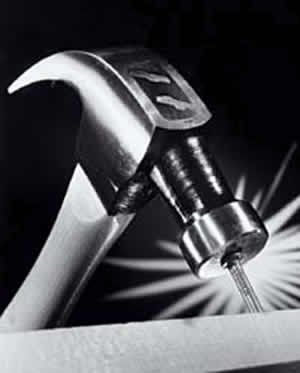Claw Hammers (Download)
Claw Hammers 1 What is a claw hammer? Claw hammers are designed to drive nails of various types and sizes. They are also equipped with a “claw” by which to remove nails In construction claw hammers are mainly used by carpenters. 2 History Hammers date back to the stone age, having otherwise obscure origins. Early hammers were stone with wooden handles. Originally utilized for hunting, craftwork, and everyday use. 3 General Information Claw hammers range from 12 to 30 oz , 11-16” in length. Face can be milled (framing hammer), or smooth (finish hammer). Common Hammer Sizes 4 Safety Concerns The claw hammer is not a direct cause of construction fatalities. I nstead , fatalities and injuries result from misuse of the claw hammer outside of its intended purpose. Striking fingers with a claw hammer is a common type of injury . Dropped hammers can cause injuries to workers working below . Claw hammers may cause serious injuries to workers in the surrounding area , as when they are in the path of the hammer’s swing. Source: Extracted from OSHA Accident Investigation Data 1990-2009 5 Related statistics 7 accidents in v olving the use of claw hammers were investigated by OSHA from 1990 thru 2009. They resulted in 7 deaths and 1 injury. 6 Example Fatality Description Fatality caused by claw hammer misuse: Employee fell approximately 20 feet from the structural steel while ‘shaking out’ web joists. The employee was using a claw hammer to grasp the joists and pull them into position. Source: Extracted from OSHA Accident Investigation Data 1990-2009 The worker swung and missed with the hammer and the momentum caused him to lose his balance. The worker fell to the concrete floor where he struck his head and died. 7 Example Fatality Description A worker was standing on a ladder beside an 8-ton sandblasting pot. The pot was pressurized to 140 psi and contained coal slag. The lid (12’ diameter, 20 lb ) was held in place by 5 bolts and tightening handles. The worker loosened the lid by using the claw hammer which resulted in a sudden release of air pressure and slag. The lid was blasted in an upward direction, knocking the worker to the ground. He was decapitated by the lid. The head was found approximately 153 feet from the pot. Source: Extracted from OSHA Accident Investigation Data 1990-2009 8 Example Fatality Description A piece of glass (approx. 77″5/8 X 94″1/2, 250 lbs ) was being installed into the tracks of a showcase but the glass did not fit and was jammed between the upper and lower tracks. A worker tried to force the pane of glass into the tracks by hitting the left corner of the glass with a metal hammer protecting the glass with only a thin and narrow piece of wood T he glass suddenly shattered and the cracked shards, some as large as several square inches fell on workers that were holding the glass in place. One worker who received deep lacerations on the right lateral neck was pronounced dead at the scene and another worker was treated in the emergency room and released. Source: Extracted from OSHA Accident Investigation Data 1990-2009 9 OSHA Requirements The OSHA regulations (29 CFR 1926) do not specifically mention claw hammers . Source: OSHA 29 CFR 1926 10 Repetitive Motion Injuries Source: http://www.emedicinehealth.com/repetitive_motion_injuries/article_em.htm Among the most common injuries in the US. are tendonitis and bursitis. Symptoms include: p ain , swelling, decreased movement ability. These conditions usually require long term treatment. Prevention: Take frequent breaks from work to allow the tissues of the arm to relax. 11 PPE and Manufacturer’s Warnings Safety glasses are to be worn by the user and bystanders. Never strike a hammer against any hardened metal objects or tools. Use the hammer for its intended purpose; use the right hammer for the job. Discard hammers with cracks, chips, or “mushroomed” heads. Source: http://www.estwing.com/safety_alerts.php 12 Safe Use Hold handle in the natural position; do not choke up. Hit the nail directly, not from an angle or with glancing blows. If nail removal is difficult, use a block for leverage. 13 Think Safety Work Safely 14

